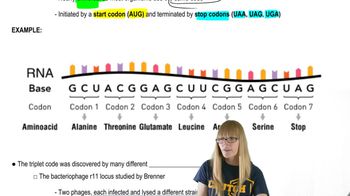Here are the essential concepts you must grasp in order to answer the question correctly.
Genetic Code
The genetic code is a set of rules that defines how the information encoded in DNA is translated into proteins. It consists of codons, which are sequences of three nucleotides that correspond to specific amino acids. This code is universal among most organisms, highlighting the commonality of life. Understanding the genetic code is essential for grasping how genes dictate biological functions.
Recommended video:
Transcription
Transcription is the process by which RNA is synthesized from a DNA template. During transcription, the enzyme RNA polymerase binds to a specific region of the DNA and unwinds the double helix, allowing it to read the nucleotide sequence. The resulting RNA strand is complementary to the DNA template and serves as a messenger that carries genetic information from the nucleus to the cytoplasm for protein synthesis.
Recommended video:
RNA Types
There are several types of RNA involved in the process of gene expression, including messenger RNA (mRNA), transfer RNA (tRNA), and ribosomal RNA (rRNA). mRNA carries the genetic information from DNA to the ribosome, where proteins are synthesized. tRNA helps translate the mRNA sequence into a specific amino acid sequence, while rRNA is a structural component of ribosomes. Understanding these RNA types is crucial for comprehending how genetic information is expressed.
Recommended video:
 Verified step by step guidance
Verified step by step guidance Verified video answer for a similar problem:
Verified video answer for a similar problem:
